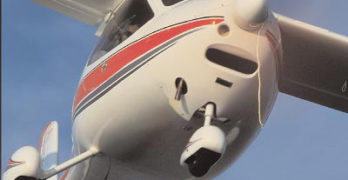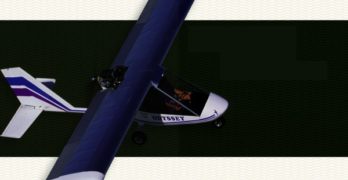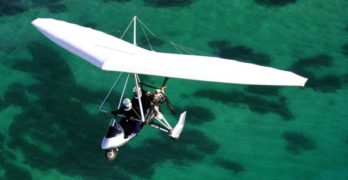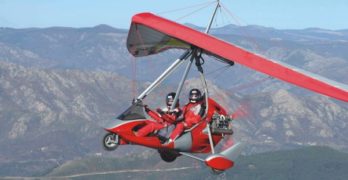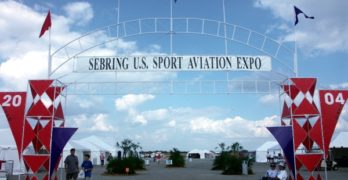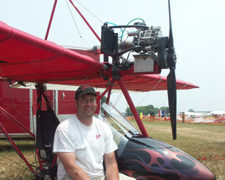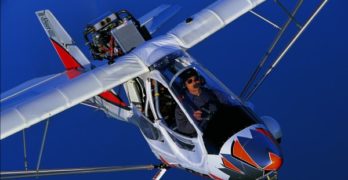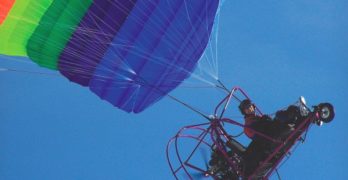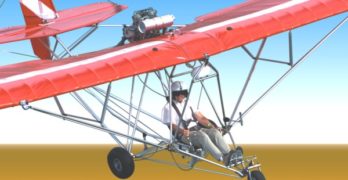A Bold Yet Efficient Euro-Designed Light-Sport Aircraft
Flightstar imports the CT2K in anticipation of the light-sport aircraft rule.
As FAA’s proposed light-sport aircraft
rule looms ever closer, one
of the first aircraft that will likely
fit the field and be recognized by American
pilots is Germany’s CT. For the U.S.
market, and with a nod to the new millennium,
producer Flight Designs has
renamed the model as the CT2K.
“CT” stands for Composite Twoseater.
It is certainly not alone in being
“white, glass, and built overseas,” a
theme that emerged at EAA AirVenture
Oshkosh 2002. But the design was a
leader in the move from tube-and-rag
ultralights to the modern microlights of
Europe. And it distinguishes itself in a
number of ways that we’ll explore in
this review.
My experiences flying the CT on two
occasions were both with Europeanbased
check pilots. The most recent
opportunity was with Allistair Wilson,
formerly a major with the Royal Irish
Regiment in Northern Ireland.
Search Results for : four-stroke
Not finding exactly what you expected? Try our advanced search option.
Select a manufacturer to go straight to all our content about that manufacturer.
Select an aircraft model to go straight to all our content about that model.
Earthstar’s Odyssey Continues
After flying many ultralight and light-sport aircraft, I’ve found the handling
and performance characteristics of Earthstar Aircraft’s machines
suit me as well as or better than any others. With that said, let me
tell you about some significant changes that may thrust this small
California company into the mainstream of light-sport aviation.
Mark Beierle created the Thunder Gull series of ultralights after working in the
aerospace industry … and being discouraged with the ultralights available in the
early 1980s. He was interested in perfecting his designs, so his priority was not producing
numerous units. Instead, he wanted to produce an aircraft with classic flying
characteristics. Customer response to his machines was excellent, but delivery
often stretched into months, even years. To own a prized Earthstar model, you had
to have patience. This situation gave another company, Titan Aircraft, a chance to
build a similar design, the Titan Tornado, and its business took off while Earthstar
remained deliberately small.
AirBorne’s XT 912 Trike
Racing to be the first weight-shift S-LSA
In early January, the FAA accepted the ASTM consensus standards
for weight-shift control (WSC) aircraft, commonly known as trikes.
The agency’s action paved the way for trike manufacturers to certificate
ready-to-fly machines as special light-sport aircraft (S-LSA). Now,
the race is on to see which company will be the first to complete the
steps necessary to show compliance with the newly approved standards.
One company in the running is
AirBorne Australia, and it is already
accepting orders for its S-LSA model,
the AirBorne XT 912. How can it be so
confident this model will comply? Its
machines already meet Australia’s tough
certification standards, so the effort is
primarily one of paperwork. (Though
preparing documents to the FAA’s precise
requirements is no trivial task, as
anyone who has tried to correctly fill
out the sport pilot certificate application
knows.) Interestingly, Australia is
one of two nations-Colombia is the
other-that have accepted the sport
pilot/light-sport aircraft (SP/LSA) rule
as part of their national program.
High-end, High-energy Alternative
On the horizon
Air Creation’s new TanarG is a high-end, high-energy alternative.
Thanks to aviation pioneers in France, Americans use terms such as empennage, aileron and fuselage. For 2005, we can learn a new French word: TanarG. This is the name of a new aircraft from Air Creation, the world’s largest trike builder. And based on a first review, this is the slickest rig from the company to date.
At first glance, the TanarG Air Recreational Vehicle (it’s a trike) may appear like the company’s Clipper model, but look more carefully. This new chassis has so many changes that up close, it bears little resemblance to earlier models.
What’s In a Name?
When I first heard from John Kemmeries of Air Creation USA, he said that the term tanarg “is an ancient word meaning a strong natural force, such as a tsunami.” Given last January’s earthquake in the Indian Ocean and the subsequent disaster, tsunami takes on new meaning.
Sebring 2004: First Impressions
The U.S. Sport Aviation Expo in October 2004 was the first event to focus exclusively on Light-Sport Aircraft.
ou never get a second chance to make a first impression. With that in mind, you might ask how visitors regarded the first U.S. Sport Aviation Expo, held in Sebring, Florida, from October 28-31, 2004. The Expo was the first of its kind aiming at the new Sport Pilot/Light-Sport Aircraft (LSA) segment, and it was a focused event, featuring only LSAs and ultralights. Is that two strikes against it or two good reasons for it to succeed?
From what I could see, those who attended the Sebring event were satisfied. Set aside for the moment reports elsewhere that the show was sparsely attended. It was the first of its kind. And as word of mouth is accepted to be the best marketing tool for shows, the attendance figures should present no surprise. The vendors were satisfied, and visitors also seemed to feel good about the selection of aircraft, the availability and ease of demo flights and the wide array of educational forums.
Tom Ivicevich’s Wright Flyer
The Wrightness of one man’s dream
On December 17, 2003, Tom Ivicevich’s Wright Flyer won’t represent the only attempt to recreate the brothers’ famous accomplishment. Nor will he be the only Wright pilot flying cross-country to arrive at the sand dune shrine in Kitty Hawk, North Carolina. But Ivicevich will do it all without major sponsorships. And he intends to fly coast to coast in his enhanced version of the original Wright Flyer.
This is one man’s dream, and he is well underway to reaching his goal.
Creating Interest
In January this year, Ivicevich’s 5¼8-scale Flyer flew while being towed by a 1930 Model A pickup truck at Redding Municipal Airport in California. The 190-pound aircraft took readily to the air at 25 mph.
In February, Ivicevich announced, “I am now organizing the start of construction for the full-size Flyer.” Next year, he plans to launch from Torrance, California, and make his way across the country.
Innovating for Part 103 Ultralights
How can a Part 103 use a four-stroke engine? Well, you can elect the half-VW from Hummel…or you might try a rotary engine as seen at the 2005 Mid-Atlantic Fly-in. This innovative racing cart engine is being developed for Part 103 ultralight use (yes, to make the weight, with electric starter!) by Erik Pederson, the new president of Phantom Aeronautics. Impressively educated, Eric has a BS in Aero Engineering plus an MS and PhD in Mechanical Engineering. Watch for a test report when Erik is satisfied with the performance.
Quicksilver’s GT500 Qualifier
Quicksilver’s GT 500 is ready for sport pilots
In the automotive world, GT stands for Grand Touring and that may be an appropriate comparison for the GT 500 from Quicksilver Aircraft Manufacturing. With the unlimited view from the front seat of this tandem two-seater, touring in the GT 500 is definitely a treat.
When the sport pilot/light-sport aircraft (SP/LSA) final rule arrives on the aviation scene, this top-of-the-line model from the longtime Southern California ultralight manufacturer may well be one of the first available ready-to-fly light-sport aircraft (LSA). Quicksilver co-owner Carl von Hirsch has indicated the company will build the GT 500 as a ready-to-fly Special LSA. It will also offer the strutbraced MX Sport IIS as a LSA entry.
You might say the GT 500 is preapproved; in 1993 the tandem, two-seat aircraft received both a type and production certificate in the Primary Category (see sidebar). It’s pretty safe to say that the design will quickly pass muster under the FAA-mandated LSA consensus standards under development by ASTM International.
Blue Heron Marathon
Built lighter to fly better
It may be hard to believe that a company established in 1995 can be considered an old-timer in an industry, yet that’s precisely the case with Heldeberg Designs LLC and its line of Blue Heron powered parachutes (PPCs).
Nick and Marie Viscio founded Heldeberg Designs a decade ago and believe they are the second oldest, continuously operating powered parachute company in America. Only Six Chuter has a longer history under the same management and ownership.
Nick and Marie run the enterprise with help from son Nicholas D., who has a degree in mechanical and aeronautical engineering, and three part-time employees assisting with fabrication and welding. “Nick is very hands-on in operating the company,” said Mark Bayer, Heldeberg’s New York dealer with whom I flew at Sun’n Fun 2004. He added, “They’re not trying to be the biggest manufacturer, just the best.”
Why did the company choose the Blue Heron name for its machines?
Breese With HKS Engine Is A Winner
Twenty-something years of ultralight flying have seen many changes take place in our ultralights. At the beginning of the ultralight industry we had craft such as Eagles, Weedhoppers, and Quicksilvers powered by engines like the 15-hp Yamaha, Mac 101, and Chrysler. Of these, only Quicksilver remains vibrant.
Here in 2004, we have aircraft like the Breese DS with its 60-hp HKS 700E 4-stroke engine. It may look like a Quicksilver but it’s a different flying animal. M-Squared’s Jay Stevens gave me a checkout in the single-seat Breese with its Japanese 4-stroke powerplant and it proved to be a very satisfying experience.
Strong and Powerful
The resemblance to Quicksilver, especially the California company’s strut-braced model, is obvious to most ultralight veterans but Breese manufacturer M-Squared has steadily changed their design. Looks, therefore, can be deceiving.
The use of struts first set apart the designs of Paul Mather, proprietor of M-Squared. A tailplane that uses no cable bracing added to the different appearance.
- « Previous Page
- 1
- …
- 7
- 8
- 9
- 10
- 11
- …
- 13
- Next Page »


